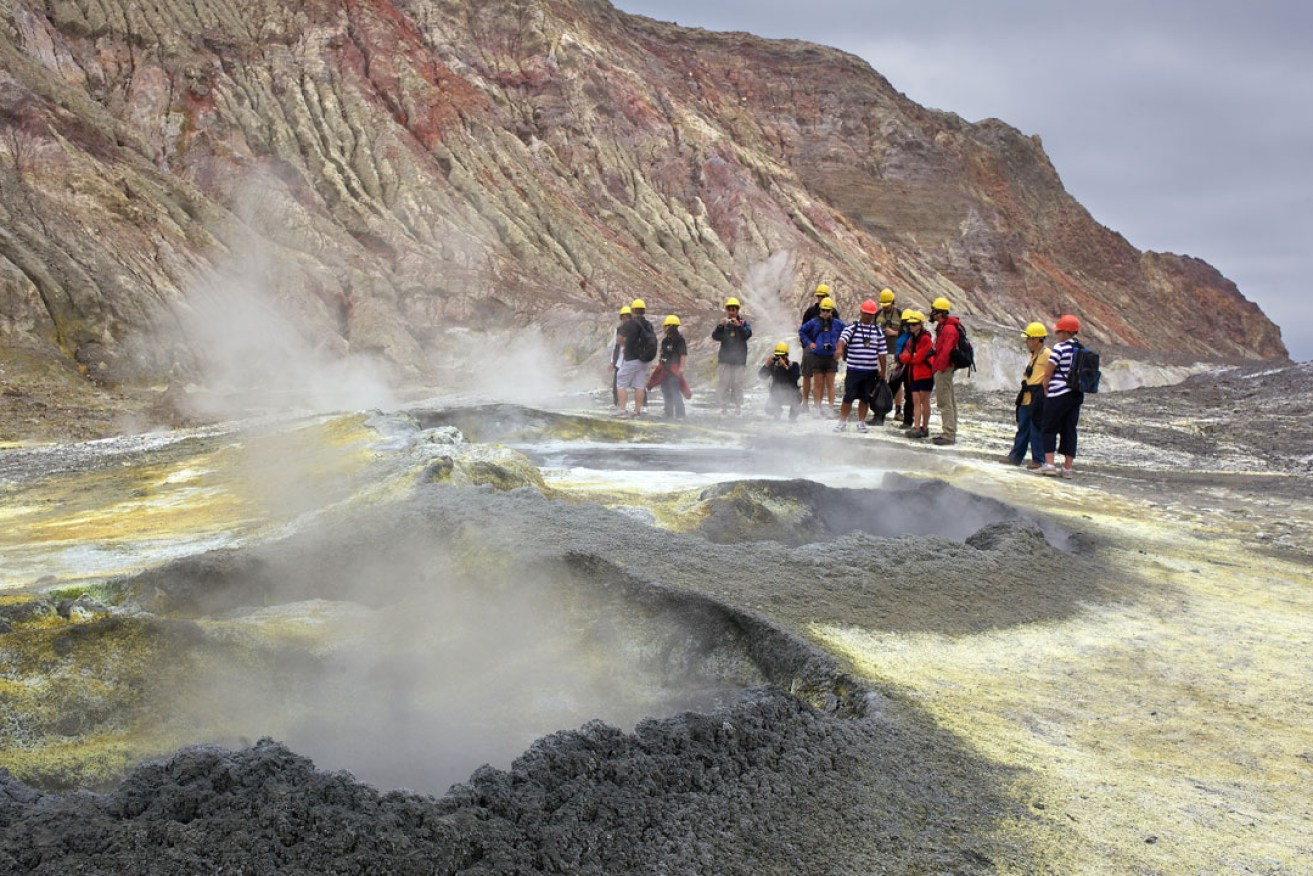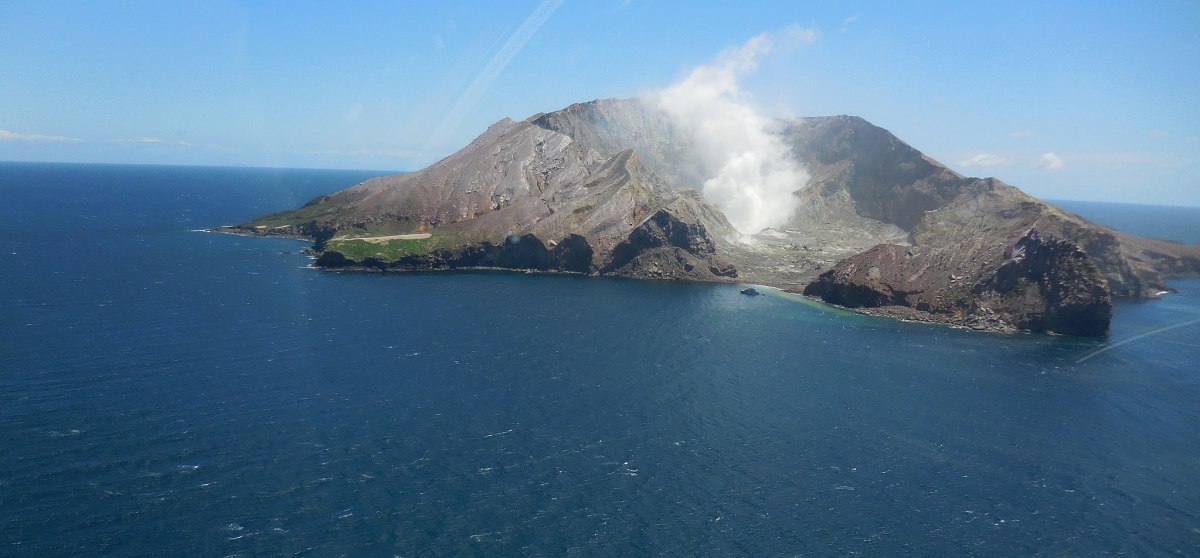Visiting New Zealand’s most active volcano
A boat trip to White Island offers a close-up experience of New Zealand’s most active volcano – complete with spouting sulphur and tall tales of historic heroes such as the lone survivor of a 1914 eruption.

Tourists on White Island, New Zealand. Photo: Tim Clayton / AAP
It’s hard to imagine a lone pussycat on a hilltop, calmly licking his paws as calamity billows behind him.
But even though it seems unlikely that a cat could outlive 10 men in a volcanic landslide punctuated by spewing sulphur, it did actually happen 100 years ago on New Zealand’s White Island.
The story of how Peter the tabby became the lone survivor of a shocking geological catastrophe in 1914 has become a legend in a country already brimming with myths and fantastic, heroic stories.
About 10 miners had set up camp to get a sulphur-harvesting operation underway on the island – about a 90-minute boat ride in today’s terms from the coastal North Island township of Whakatane.
The country’s most active marine volcano was dangerous terrain with sulphur spurting, shooting and steaming out of angry yellow chasms amid an environment acidic enough to literally digest you as you work.
Still, no one was expecting to turn up one day and see the landscape had shifted so dramatically, with seemingly no survivors.
But standing among the rubble, looking every bit the risen Phoenix, was Peter the cat – quickly renamed Peter the Great.
Peter was whisked away to the nearby mainland township of Opotiki, where the fecund feline sired many kittens, considered exceptionally good luck by the townsfolk.
There’s something fantastical about this landscape that lends itself to legends, so it’s not surprising this story remains in the region’s modern folklore. This is the region the Maori first arrived in 800 years ago searching for new land and the highly prized green stone – commonly known today as jade.
But while new tales are firmly entrenched in the region’s zeitgeist, the old stories were starting to fade away.
On a trip to White Island – known in Maori as Whakaari – tour sea operations manager Paul Kingi tells me how Maori people are scrambling to reclaim their history, their stories, their language, and halt all of this treasure “going to the grave”.
Paul, 53, is able to trace his Maori ancestry back 27 generations to a tribal chief who first arrived in New Zealand via this remarkable coastline in his weka (canoe).
He says it’s important for Maori people to preserve their stories across the nation as best they can. It’s a recent thing – when Paul was at school, the government had banned children from speaking Maori. The same went for his mum and his gran. It’s only today’s generation that again is encouraged to learn its native tongue.
But along with the banning of the Maori language went their stories, too. Luckily, young Maori people in New Zealand these days are speaking their native tongue together, bringing fresh energy and a resurrection to their culture, which some say they almost lost.
Paul says it’s vital for Maori people to know their history, stories and language.
“Unless you know where you come from, you probably won’t know where you’re going to go,” he says.
Perhaps one of the oldest stories Paul tells me is a rather sweet – and odd – love story. White Island, or Whakaari, is a female mountain who was pursued by the already-married mountain Taranaki. The problem was that mountains can only move at night, and they can only move once, and by the time the sun had come up, Taranaki had not even come close to Whakaari.
Another legend highlights a beautiful statue of a young girl at the Whakatane waterfront. Wairaka was the daughter of a Maori chief who first came to the region. She heroically saved the women of her group from floating out to sea.

A 2014 aerial image of White Island. Photo: David Broad / Wikimedia Commons
The boat trip to White Island is wonderful – dolphins frolic beside the vessel and staff are on-hand to share the region’s stories. But arrival at the island is most magical of all. Sulphur hisses, steams and spouts out of holes.
Certain parts of the terrain are a strict no-no for walking – the land here is like eggs full of molten rock – so you need to be careful where you put your feet lest those “eggs” crack open.
But it’s not inaccessible – visitors are permitted to taste the sulphur rocks found on the ground, and even sample the iron-rich “volcano juice” – streams of hot water that flow from the mountain itself.
A walk around the island is also full of stories – of a tragic suicide by an explorer, whose shoes were found beside a notorious volcanic ledge. Another story tells the tale of a would-be miner who tied himself to a post when he saw the treacherous terrain.
More recently, Kiwi supermodel Rachel Hunter made waves when she returned to the island for a glamorous photoshoot.
But far from being a distraction from Maori history, these modern stories seem only to continue the folklore – and the magic. And it’s the very telling of the stories – to tourists, to journalists, or to anyone who listens – that keeps that history alive.
Getting there: White Island Tours will pick you up from the waterfront at Whakatane and take you on a half-day tour. Price is $NZ219 ($A204).
The nearest airports to Whakatane are Rotorua and Tauranga. Travellers from Australia can fly to Auckland and onwards with Air New Zealand.
Staying there: White Island Rendezvous shares its reception area with the tour check-in, and it’s across the road from the pick-up area. Accommodation starts at $NZ119 ($A110) a night.
Tour and accommodation package deals can be booked at www.whiteisland.co.nz
Other legendary volcanoes worth visiting: Mt Tarawera at Rotorua offers an incredible crater walk experience. Visit www.kaitiaki.co.nz/guided-tours.
Skyline Rotorua is a family fun experience with a scenic chairlift, followed by a luge ride and a massive, sumptuous buffet on the top of Mount Ngongotaha.
The island volcano Rangitoto is another option for those visiting Auckland. See www.rangitoto.org
For more, www.newzealand.com
The writer travelled as a guest of Tourism New Zealand
-AAP




